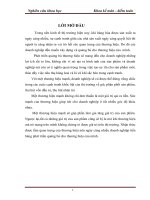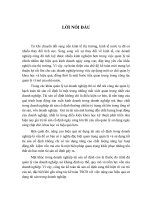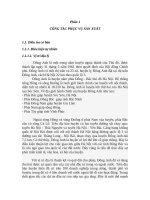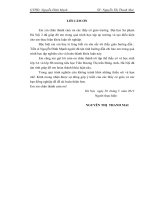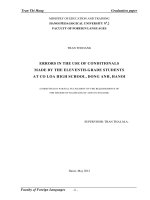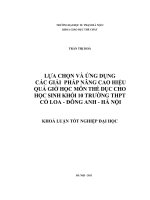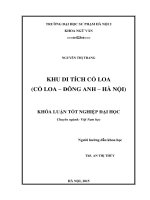Co loa festival Lễ hội Cổ Loa tại Đông Anh Hà Nội
Bạn đang xem bản rút gọn của tài liệu. Xem và tải ngay bản đầy đủ của tài liệu tại đây (754.99 KB, 17 trang )
Table of contents
CHAPTER I. INTRODUCTION
1. Rationale.
Vietnam is a country which has many festivals in a year. Vietnam’s festivals usually
focus on spring. The festival is a type of traditional cultural activities, a product of Vietnamese’s
spirit which formed and developed throughout the history of nation. Each festival has a typical
feature and private value, but all of them worship and respect the supernatural power or the
national hero… The festivals that are the occasions for the later generations express their honor
to the previous generation are as a bridge between the past and the present. They show the
thought “When you eat a fruit, think of the man who planted the tree” of Vietnamese people.
Vietnamese people consider festival is an indispensable part in their spiritual life. The festival is
an occasion not only for expressing their respect but also for enjoying and relaxing after a hardworking year. Nowadays, Vietnam’s festivals attract many tourists annually to enjoy and learn.
Festivals have become an important part, a “product” of tourism industry. They are the source
information for foreign tourist knowing more about Vietnam.
Co Loa festival is the one of the big and important festival in a year of Vietnam. It is held
to commemorate the national hero King An Duong Vuong who built the Co Loa citadel and
founded the Au Lac nation. Annually, this festival attracts many Co Loa villagers and visitors. It
is very important to have enough knowledge about the Co Loa festival in particular and other
festivals in general. Good knowledge can help we develop the tourism industry of Vietnam.
We are the student of Faculty of Tourism so we need to understand and know well the
important of the festivals in Vietnam. The festivals are the one of aspects of culture which
figures as an important role of the tourism industry. Thus, our group learnt about one festival
inside a hundred of festivals in Vietnam. That is Co Loa festival.
2. Objectives of the study.
When completed this assignment, we got two main objectives: knowledge about Co Loa
festival and reporting skill.
Firstly, we learnt more about the festival in Vietnam especially Co Loa festival. We knew
exactly the day when people celebrate Co Loa festival. We also knew the reason and confirmed
once more time about legend of Co Loa festival. Moreover, we had knowledge about the way Co
Loa’s villagers prepare and hold the festival, some activities in Co Loa festival.
Second, assignment is an occasion for us to practice collecting information skill,
analyzing skill and the most important is writing skill. We also knew how to improve our team
working when we did this assignment.
3. Methodology.
To complete the assignment, we found newspaper, magazine and some articles writing
about Co Loa village and Co Loa festival. We also collected information on the Internet through
articles and video.
4. Scope of the study.
Our topic is Co Loa festival which is held in Co Loa village so the scope of the study is
determined in Co Loa village, Dong Anh district. The content is legend of Co Loa festival, some
preparations before festival, some activities in the festival, process of the ceremony. Study time
ranges from 6th day to 16th day of the first lunar month.
5. Structure of the study.
Our assignment includes three chapters:
Chapters I: Introduction.
In this chapter, we present why we research about Co Loa festival and the outcomes of
the assignment. We also list some methodology which used to complete our assignment. Next,
we define the limitation of our study.
Chapter II: Body.
In this chapter, firstly, we present the background information of Co Loa festival like
place, meaning, purpose… Next, there are history of the ceremony, preparations before the
festival, some rituals and activities. We also research some special characteristics and some
changes of the festival. Last but not least, we give some advice for visitors attending this festival.
Chapter III: Conclusion and recommendations
In the last main chapter, we make summary of the Co Loa festival. Next is our final
comment about the festival. And finally, there are our suggestions to attract more student and
tourists.
In addition, our assignment has two other parts: Reference and Appendix. In the
Reference section, we list all name of source or link which we found and read information.
Appendix is a part in which we have some pictures about the festival.
CHAPTER II. BODY
1. Background information of the festival.
Co Loa festival is one of the typical festivals in Vietnam which commemorates and worships
King An Duong Vuong. The festival is annually held in Co Loa village, Dong Anh district, lasts
ten days from 6th to 16th day of the first month of lunar year, and the main festival day is on 6 th
day. It is established by eight communes – “Bát Xã” (Đài Bi, Sàn Dã, Cầu Cả, Mạch Tràng, Văn
Thượng, Thư Cưu, Cổ Loa, Xép) to commemorate An Duong Vuong – Thuc Phan who founded
ancient Vietnamese nation – Au Lac and built Co Loa citadel. The festival is taken place at
Thuong temple in which King An Duong Vuong is worshiped. The festival not only has rituals,
traditional procession but also takes place some folk game like crossbow, swinging, wrestling,
human chess... in front of Thuong Temple. The festival is an occasion for the villagers enjoy
after a year hard-working and pray for the coming year will be lucky and happy.
2. History of the Co Loa festival.
Co Loa festival is based on a legend about King An Duong Vuong and his magic crossbow,
besides is My Chau, Trong Thuy, Genius Kim Quy – a Golden Tortoise.
According to book History Vietnam, An Duong Vuong spent ten years defeating Tan Thuy
Hoang’s soldiers to protect Vietnamese ancient nation. When the country gained independence,
An Duong Vuong crowned King. Then he renamed Van Lang to Au Lac and established Co Loa
as a new capital. To strengthen military defenses, An Duong Vuong decided to build Co Loa
citadel. But the construction had a lot of difficulties. The citadel built and rebuilt several times,
but not be completed.
Fortunately, Genius Kim Quy appeared and repeatedly crawled around the citadel. King An
Duong Vuong ordered to build in the footprints of the tortoise. Since then, Co Loa citadel did not
fall. Genius Kim Quy not only helped King An Duong Vuong to build Co Loa citadel but also
gave him a nail and taught him how to make a magic crossbow to protect the country. The magic
crossbow is a secret weapon of An Duong Vuong that helped him fight against any enemy. Au
Lac was endangered by neighbors countries including Trieu Da. King Trieu Da planned his son –
prince Trong Thuy married to Princess My Chau – King An Duong Vuong’s daughter.
Trong Thuy lived in Au Lac, My Chau told her father’s secret to her husband then Trong
Thuy stole the magic crossbow and returned home. After that, war happened, King An Duong
Vuong lost the magic crossbow he could not defeat Trieu Da soldier. He ride horse to East Sea
and asked for help Genius Kim Quy. Genius Kim Quy appeared and denounced My Chau
betrayed her father. King An Duong Vuong beheaded his daughter then went down to the sea.
To express the gratitude and respectful the villagers built a communal house and made King
An Duong Vuong statue, My Chau statue. Annually, villagers found the festival to burn incense
and commemorate them.
3. Preparations before the event.
Co Loa festival is a big occasion in Co Loa village so it is well prepared. Because Co Loa
festival is held by “Bát Xã” so each commune is assigned specific tasks. They need to complete
their duty well. They prepared a formal oration, traditional clothes, a washed palanquin, incense,
wine, flowers, fruits, especially Day cake and “bỏng gạo” that were food An Duong Vuong
rewarded troops. People are also an important part of the festival. They select eight “Lang Cai”
represent for eight communes who are the men over fifty, know how to organization and no bad
habit in daily life. Besides, they choose team flag bearer, “phường bát âm”, procession team who
wear traditional clothes.
The festival is prepared carefully, many days work hard of local people in the each village,
commune, all of them for one purpose: Co Loa traditional festival.
4. Rituals and activities.
The official festival day is 6th day of the first lunar month, but all of preparations were
completed before that. On the afternoon of 5th day, villagers of eight communes establish burn
incense ceremony at the communal house. On the next day – the official day, eight village
dignitaries of eight communes go to first notable's house of Van Thuong village to process
funeral oration (Van Thuong village has privileges to edit funeral oration). The funeral oration is
hung up a hanger. The first notable and village dignitaries wear traditional costumes neatly and
stand in front of the hanger, then they hold a ceremony. After that the procession funeral oration
is begun. Leading to the procession is five Five Elements flags, next is an octet, followed by
eight first notables, some village dignitaries together village inhabitants who carry the hanger
funeral oration, “Long đình” palanquins, flags and parasols. The place of the procession is An
Duong Vuong temple – Thuong temple in which people perform worshiping.
The yard of Thuong Temple is decorated by many colorful flags; pennants are fixed
straight line from road hamlet to the yard of temple. In the mid-yard, a big flag is hung in flag
tower. Closed to the temple gate has a couple of horses – red horse and white horses are
decorated colorful with bridle and saddle. On the outside, offering and eight weapons - “lộ bộ bát
bửu” are put neatly. In front of the temple, a big incense-table has worshiping objects and a
couple mandarins’ boot. Ahead big incense-table is a smaller other in which put crossbow,
swords, arrows and other weapons. In addition, people spread out some mats to genuflect in the
ceremony.
When a horn rang out signaling the literature is coming, palanquin “Long đình” is put in
front of two incense-tables. The traditional performance is accompanied by the music of the
octet. The first notable of Van Thuong village is an officiating priest. When all of the main
offering team of eight villages complete their rituals, other villages and visitors pray King An
Duong Vuong for lucky, happiness and wealthy. The worshiping ceremony is completed at 12
o'clock.
Next procession is God procession. The first is flags, palanquin and eight weapons. Next,
the octet, some village notables wear traditional costume bringing King's weapons. Dignitaries,
men in Chua hamlet, Co Loa village carries a palanquin in which put a King An Duong Vuong‘s
ancestral tablet. Followed by others village, each village has a particular palanquin with colorful
flags and the octet. The procession is very crowded and the music of the octet can be heard
everywhere. The starting point is Thuong temple then around the Ngoc well, followed road of
Noi citadel, then Ngu Trieu temple. When the procession goes to intersection of Co Loa village,
the palanquins return their own village. Co Loa's palanquin goes to Ngu Trieu temple and Co
Loa villagers hold the worshiping once more time. By the time, it was dark and the official
festival day was completed, but that is only ceremony of Co Loa festival.
Co Loa's part of activities last to 16th day of first lunar month. In this part, villagers
establish many traditional games and activities. In the daytime, elder man play cards, chess and
human chess. Elder woman go to the temple and pagoda. Besides, younger people have many
exciting games like: swinging, wrestling, tug of war, archery, cock fighting, and rice cooking
competition. In the night, people burn fireworks, perform some kinds of traditional music such as
“chèo”, “tuồng” and “ca trù”.
On the last day of the festival, villagers hold a farewell ceremony at the temple. The
rituals in this day are similar to the official festival day. The ancestral tablet of King will be
returned to the sanctuary. People believe that they will be enjoyed the best things in the coming
day and the protection of King An Duong Vuong and Princess My Chau.
Both rituals and activities create a special and lively Co Loa festival. It always maintains a
private characteristic despite handing down many generations.
5. Special characteristic.
Co Loa people always handed down a folk:
“Die, give up children, give up grandchildren
When living do not give up 6th day of first month”
6th day of first lunar month is the official festival day of Co Loa festival. According to legend,
6th day of first month was chosen as the coronation throne. Co Loa festival has many unique
characteristic, but the most special characteristics are: the participation of Quay village, offertory
included Day cake and “bỏng gạo” and the procession fake King of Nhoi village.
Firstly is the participation of Quay Ca village in Co Loa festival. Quay village is the first
village holds the worship, next is Co Loa village and others village. People say that Quay’s
villagers were the original inhabitant who ceded land for King built citadel. They were loved by
King and respected by others village.
Next is the procession fake King of Nhoi village. In the Sai mountain of Nhoi village,
there is a Tran Vu village in which worship a deity. Legend has it that this deity helped King to
build Co Loa citadel. When it completed, An Duong Vuong went to Sai Mountain to make
Thanksgiving. Moreover, King decided to build a temple to worship that deity and on 12 th day of
first lunar month King and bureaucrats went to this temple to worship. Later King assigned this
responsible to Nhoi’s villagers. The villagers could pretend to be King and held the worshiping
just like the real. Annually, villagers take place this ancient story. The villagers will choose an
elder virtuous man to act King. In spite of a private custom of Nhoi village, it contributes the
various activities in Co Loa festival.
And the finally is the indispensable offertory: Day cake and “bỏng gạo”. According to
legend, they were the food which An Duong Vuong used to reward troops. Because of the
offertory, people who make them are abstinence before roasting and crushing. “Bỏng” are made
from yellow sticky rice. People choose good and delicious paddy then they fall the paddy down
ground about five days to have a best result. It is made in this festival occasion.
6. Some changes.
Nowadays, festival becomes an important part of Vietnamese’s life. Spring is the season
of festival and enjoyment. Co Loa festival is the most important of Co Loa villagers. Annually,
the villagers always come back their home to participate in the festival.
Co Loa festival is not only a festival of Co Loa villagers but also an occasion of others
Vietnamese people who come from many provinces even overseas. The festival attracts many
people so scale festival is more and more growing. People hold a lot of activities, game, souvenir
stalls which help the villagers to develop tourism and economy of Co Loa village. Although the
festival is crowded, security problem in the festival is better, visitors always feel safe and
comfort when they come to the festival.
Besides the positive changes, Co Loa festival still has some limited issues. Firstly, the
festival is commercialized. When going to the festival, the first things are small stalls which sell
a lot of unsuitable things to temple and festival like: food, violence toy, even exchange money.
Moreover, the sale persons sell at high price for profit with some items such as flower, souvenir,
incense and votive paper. The other negative issues are disguised gambling, superstitious, bet.
The pickpockets and theft still exist in the festival. All of them are still public appearances and
ignores the patrol and control of functional forces.
That is the negative impact of local people, visitors also have some adversely affecting
for the festival. They exchange money at gate temple and when they go to Ngoc well and inside
the Thuong temple, they put money in everywhere they want: statue, well, road of temple.
Another negative issue is burn incense and votive paper. Visitors burn too many incense and
votive paper making smoke and dust many place in the temple.
The negative impacts diminish the meaning of the festival. This makes loss of the original purity
and sanctity of the unique festival which handed down many generations.
7. Advice for visitors attending these events.
Co Loa festival is an interesting occasion for tourism. If you want to participate in this
travel, the followings are useful tips for you.
Offertory: You should by small offertory which easy to bring like flower, incense, votive paper,
some kinds of fruit. All of them can show your respect to King An Duong Vuong, you need not
buy the big and too more items. The best offering is your heart.
Behavior: Co Loa festival is an occasion to respect to King An Duong Vuong so when you
coming here you should have an appropriate attitude. When you participate in the worshiping
ceremony, you should keep silence, don’t laugh or shout. You can visit around Thuong temple
and Ngoc well however you should not leave small change at any place you want. That action
does not help you to have much luck as you want. If you want, you should put them in the
charity-box put in the temple by managements.
Safety: When traveling to the crowded festival like Co Loa festival, you should pay attention to
your luggage. The thieves often take advantage of crowded places to pickpocket. You just
neglect a little bit, you will be lose your money, your wallet or other valuables.
Activities: You can join in or view some traditional game when traveling to festival such as:
swinging, rice cooking competition, cock fighting, folk music.
8. Summary of some characteristic features of that place.
a. The geographical location
Co Loa located in Dong Anh- is a suburban district, which is located in south of the Red
River and is bordered by the Northern District- Tu Liem, south east of Duong River and Long
Bien district bordering Gia Lam district. The natural area is 18,230 ha. The population is 327 500
people. Dong Anh is the second largest district Ha Noi.
The district has two railways: Hanoi - Thai Nguyen and Hanoi - Yen Bai. Noi Bai International
Airport is connected to the inner city Hanoi on highway 3 and Thang Long- Noi Bai, 7.5 km
long running through the Dong Anh district. Therefore, the Dong Anh district is a major
advantage for transportation. These are favorable conditions for interaction between Hanoi and
northeastern provinces. This is the premise of promoting economic, social and cultural districts.
With favorable geographical location and land allows, Dong Anh has attracted the
attention of investors at home and abroad. The district has more than 100 central enterprises,
cities and districts, including four joint ventures with foreign countries have come into operation.
It is also considered to be located in areas planned for industrial development, urban services,
and tourism is a key transportation hub connecting Hanoi to Northern provinces
b. The natural landscape, cultural, historical
Dong Anh is a district which has the thickness of history, culture, revolution. The district
has 205 temples; 10 places are the basis of the revolution. Includes 28 temples, where the state
has been ranked as the historical and cultural. Typically, Co Loa, Sai Temple, Nam Hong tunnel.
Co Loa is a famous historical site, located in the town of Co Loa. King An Duong Vuong built
around the year 257 BC, it is the capital of the Au Lac. Currently, Co Loa is one of 21 national
tourist resort, was recognized national historic special of Vietnam on 01/06/2013 lunar calendar.
Sai Temple on the Sai Mountain, Thuy Lam is an ancient architectural work, which is considered
one of the oldest buildings; the most beautiful remains are kept in North Delta. It is famous for
ceremonial procession of the living king (the King is played by the elder person who is virtuous
and talented impersonator in the village). Tunnel Nam Hong is a typical network of historic sites
built during the French war. There are also other unique festivals such as the Cao Phong village,
Son Du, Duong Yen village, etc.
At Dong Anh still maintained by some kind of cultural, artistic, traditional festivals,
imbued with the national identity as ca tru, wall, sailing and so on, at the local as Thuy Lam,
Kim Chung, Nam Hong, Bac Hong and so on.
Many villages in Dong Anh still keep traditional crafts such as carving, lacquer, wood Van Ha,
Lien Ha, Thuy Lam, Tu Duc and rattan bamboo in Van Noi, Mai Lam.
CHAPTER III. CONCLUSIONS AND RECOMMENDATIONS
1. Conclusions
Assignment Pet 3 is an important exercise; it covers the main content of traditional
ceremonies and festivals in Vietnam. Co Loa Festival is one of the major festivals of the country.
It is not only expresses unique art and culture of Vietnam, through which people have the
opportunity to gratitude, respect and worship the King An Duong Vuong.
Every year, Co Loa festival was held from 6th to 16th on the first lunar month in the
town of Dong Anh, Hanoi. On this day the people of Vietnam as well as domestic and foreign
tourists are concentrated in Co Loa ancient temple. The festival is organized with style standards
Festival in the past, includes two parts: part rituals and social part. Part ritual express meaning
and spiritual values of the people of Vietnam, while the social part is a chance to meet people,
relax after hours of tiring labor. When visitors come here not only to learn about the history of
Vietnam, but also to participate in traditional games such as cock fighting, swinging, rice
cooking competition, creating attractive feature of the festival.
Through Co Loa Festival we can learn something as advantages and disadvantages. We
can expand much knowledge of history, culture, ritual of our country, this is good for us.
Besides, we are very proud of the country and people of Vietnam, the hero of the nation more.
Co Loa Festival is an actually festival attractive with international tourists. In the Co Loa
festival, people around the cross to see the crowds, consider this meaningful occasion of Tet.
However, besides a number of advantages, festival still exist many problems limiting
waste, social vices, product commercialization. It makes customers feel uncomfortable when
they take part in the festival. So the organizers of Co Loa Festival must resolve negative
problems that are essential for everyone coming to the festival. It’s also an ability of us- the
Faculty of Tourism students.
Finally, when we studies of the festival, we know more about the value of mental and
physical in our life. We want to uphold the spirit of patriotism, ethnic pride, enhance the sense of
preserving and conserving the cultural traditions of the nation.
2. Recommendation
The festivals and traditional ceremonies Vietnam is very interesting, so we must protect
and develop them. To attract students, we think that it is necessary to publish several books of
festivals and ceremonies for students. Students should participate in the festival to learn more
about them. It’s also the way to develop tourism of our country.
Besides, we also get some troubles such as finding information is not easy; there are some
changes in this festival, it is difficult for us by text and English translation with significant
accuracy.
To complete this task better, we can find more information on the Internet, books or
newspapers and select the most accurate information. Moreover, the teacher gave us more tips in
finding information to do it. We think that this assignment is the best chance for us to improve
our knowledge and skills. We hope that this will be a useful experience for later courses and
expect they will have a better assignment.
REFERENCES
1. />2. />3. />4. />5. />6. />7. />8. />
APPENDIX
SOME PICTURES ABOUT CO LOA FESTIVAL
Co Loa Festival
Time: From the 6th to the 16th day of the first
lunar month, the main festival day is on the
6th day of the first lunar month.
Place: Co Loa Commune, Dong Anh District,
Hanoi.
Objects of worship: King An Duong Vuong.
Characteristics: The procession of 12 hamlets
and 7 villages, the procession of "alive" king
in Nhoi Village.
On the afternoon of the 5th day of the first lunar month, all of the eight communes (including Co
Loa Commune and the establishing relations between seven communes) hold the incense
offering ceremony at the communal house. At Thuong Temple, village officials and mandarins
hold the similar ceremony and revise the king's contributions and achievements. The official
festival day, which is on the 6th of the first lunar month, starts with processions and grand
sacrifices- offering ceremony. In early morning, a solemn and splendid procession takes
orations from the oration writer's house to the temple. The chief officiant at Thuong Temple has
to come up and receive the orations and puts them on the altar. Next to the door of the temple is
a pair of life-size pink and white wooden horses. Their harnesses are decorated with phoenix
motifs and beautiful gold thread embroideries.
The path to the temple is lined with decorative weapons and eight precious votive objects. At
that time, the palanquins of the establishing relations between seven communes arrive at Thuong
Temple and are put on the yard. The worshipping rituals begin. Votive offerings include incense,
flowers, truncated cone-shaped cakes made of sticky rice, fruits, steamed sticky rice, meat, giay
cakes and popcorn. According to folk knowledge, the last two things were used by King An
Duong Vuong to treat his troops. The rituals last until 12 o'clock. Meanwhile, in the temple,
some senior people representing their communes pray to the king for peace and prosperity to
their villagers.
Next is the procession to take the god from the temple to the communal house so that he can
watch the festivities. This is the biggest procession with the participation of all the palanquins.
When reaching the main entrance called Nghi Mon, the palanquins return to their villages.
Co Loa's procession and palanquin do the same rituals once more at the communal house. This
is the end of the official festival day. From then to the end of the whole festival, there are only
duty ceremonies and votive offerings of residential groups, family lines and visitors
An Duong Vuong Temple Festival has a special procession for the fake king of Nhoi village. On
Mount Sai in Nhoi Village is a temple dedicated to Saint Tran Vu, who, according to legends,
helps the king drive away evil spirits and build Co Loa Citadel. Every year, on the 12 th day of the
first lunar month, the king would go there together with his mandarins to do worshipping rituals.
But because such travelling was quite complicated, King An Duong Vuong asked a local man to
impersonate him and held a similar ritual. Later generations put on stage that story. Though this
custom is specific for Nhoi Village, it helps to diversify activities of the Co Loa Festival.
The Co Loa Festival has many other fun activities such as human chess, wrestling, cock fighting,
swings, rope climbing, card playing, and cheo and tuong singing.
On the final day of the festival, a grand farewell ceremony will be held at the temple. The rituals
are the same as in the main festival day. After the rituals, the cult table of god will be returned to
the sanctuary. Local people enjoy the god's favour and expect a year of prosperity and
protection from the god.
